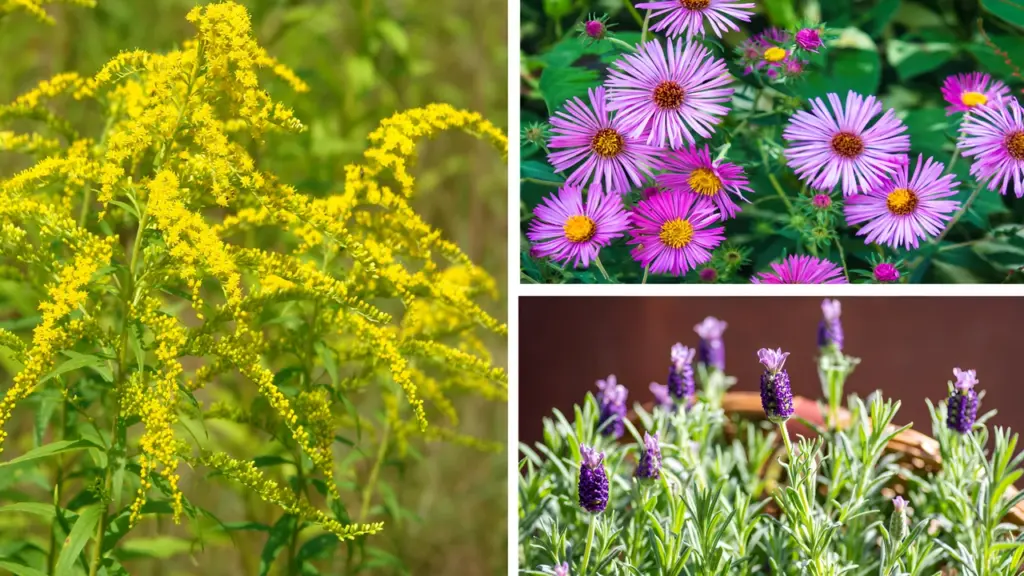Join on WhatsApp
Get the latest updates directly on WhatsApp – motivation, news & more!
October marks a shift in seasons, a time when gardens start to wind down, and the cool breeze begins to replace the heat of summer. But while many gardeners are wrapping things up for the year, October is also the perfect time to prepare your patio for a spectacular butterfly show next spring and summer. By planting the right flowers now, you can set the stage for a garden that attracts these delicate, colorful insects when they return. Here are seven plants you can plant in October to bring butterflies to your patio in the warmer months ahead.
1. Asters (Aster spp.)
Asters are late-season bloomers that produce clusters of vibrant flowers, making them an excellent choice for attracting butterflies, especially in October. These hardy perennial plants come in a variety of colors, including purple, pink, blue, and white, offering a striking visual appeal. The flowers’ nectar-rich blooms are irresistible to butterflies, particularly the late-season species like the painted lady and monarch.
Plant asters in well-drained soil and full sun, and they’ll thrive even as the weather cools. These plants will continue to bloom into the fall, offering much-needed nectar for migrating butterflies. By planting asters in October, you ensure your garden stays attractive for the duration of the butterfly migration season. Plus, they’re relatively low-maintenance, requiring little attention once established.

2. Goldenrod (Solidago spp.)
Goldenrod is another late-season nectar source that butterflies love. Known for its bright yellow blooms, goldenrod is an excellent addition to your patio garden in October. The flowers bloom in late summer and early fall, making it a go-to plant for providing food for migrating butterflies, especially in areas where the weather cools down quickly.
This plant is native to North America and thrives in well-drained soil with full sun. Its tall, vibrant spikes of flowers can attract a wide variety of butterfly species, including the common sulphur and American lady. Planting goldenrod in October ensures that your garden remains a rich nectar source as butterflies pass through your area.
3. Lavender (Lavandula spp.)
If you’re looking to combine fragrance with butterfly attraction, lavender is an excellent choice. Lavender’s soft, fragrant purple flowers attract butterflies and bees, creating a delightful atmosphere in your garden. Lavender blooms during the late summer into fall, and its sweet scent is known to draw in a variety of butterfly species, including swallowtails and painted ladies.
Lavender thrives in well-draining, sandy soil with full sun. It also needs minimal care, making it an easy plant for beginners. By planting lavender in October, you’ll ensure that your patio stays fragrant and butterfly-friendly when the weather warms up in spring. Plus, lavender’s drought tolerance means it can survive through the dry months while continuing to bloom.
4. Milkweed (Asclepias spp.)
Milkweed is the quintessential plant for attracting monarch butterflies. These iconic butterflies rely on milkweed for both nectar and as a host plant for laying their eggs. If you want to give monarchs a place to call home on your patio, consider adding milkweed to your garden in October. Not only will it attract butterflies, but it will also help with their population in your local area.
Milkweed varieties like butterfly weed (Asclepias tuberosa) are especially beneficial because they bloom in the late summer and fall, ensuring that monarchs have plenty of nectar as they migrate. Milkweed prefers well-drained, slightly sandy soil with full sun. Be mindful, however, that it can be invasive, so it’s best to plant it in a controlled space or container on your patio to prevent it from taking over other plants.
5. Zinnias (Zinnia spp.)
Zinnias are colorful annuals that bloom throughout the summer and into the fall, making them an ideal choice for extending the butterfly season. Their bold, bright flowers in shades of red, orange, yellow, and pink are a major draw for a variety of butterfly species, including the monarch, painted lady, and skippers. The flowers’ wide, open petals make it easy for butterflies to land and feed.
Plant zinnias in full sun with well-drained soil, and they will reward you with continuous blooms. Though they are annuals and will die off after the frost, their abundant, colorful flowers will provide a rich source of nectar for butterflies before the weather turns cold. Planting them in October will give you a boost for the following year’s garden.
6. Joe Pye Weed (Eutrochium purpureum)
Joe Pye weed is a tall perennial with clusters of pinkish-purple flowers that bloom from late summer to fall. This plant is a magnet for butterflies, especially those that are migrating. Monarchs, swallowtails, and other butterfly species flock to the nectar-rich blooms of this native North American plant.
Joe Pye weed does well in a variety of soil types and thrives in areas with partial to full sun. It grows tall, often reaching 4–7 feet in height, making it an excellent backdrop plant for your butterfly garden. Planting Joe Pye weed in October ensures that your garden will attract butterflies in the following months while adding a dramatic element to your landscape.
7. Coneflower (Echinacea spp.)
Coneflowers are another perennial favorite for attracting butterflies. Their large, daisy-like flowers with spiky centers offer both nectar and a safe place for butterflies to land. Coneflowers bloom from mid-summer into fall, providing butterflies with a steady source of food. The bright purple, pink, and white varieties are especially attractive to both butterflies and pollinators like bees.
These hardy plants grow well in full sun and tolerate drought conditions, making them ideal for low-maintenance gardens. Coneflowers are also beneficial in providing seeds for birds in the winter months, making them a year-round asset to your garden. Planting coneflowers in October ensures that they have time to establish strong roots before the next growing season.
Final Thoughts: Why October is the Perfect Time to Plant
When it comes to attracting butterflies to your patio, planting in October can have significant advantages. As the cooler temperatures arrive, these plants are able to establish themselves before winter sets in. Once the weather warms up in spring, they’ll be well-established and ready to provide nectar when butterflies are most active.
Moreover, by planting in October, you’re setting up your garden for the following year. Many of these plants, like asters, goldenrod, and coneflowers, are perennials, meaning they will come back year after year to continue attracting butterflies. For annuals like zinnias, they will provide a pop of color and food for butterflies in the short term, ensuring that your garden remains alive with activity until the first frost.
In summary, October is an excellent time to plant butterfly-friendly plants on your patio. The cool fall weather allows these plants to establish their roots, and by the time spring and summer arrive, you’ll be rewarded with a garden that attracts butterflies, enhancing both the beauty and biodiversity of your outdoor space. Whether you opt for the bright blooms of zinnias or the towering presence of Joe Pye weed, these seven plants will not only provide a food source for butterflies but will also transform your patio into a vibrant, colorful haven for these winged wonders.




